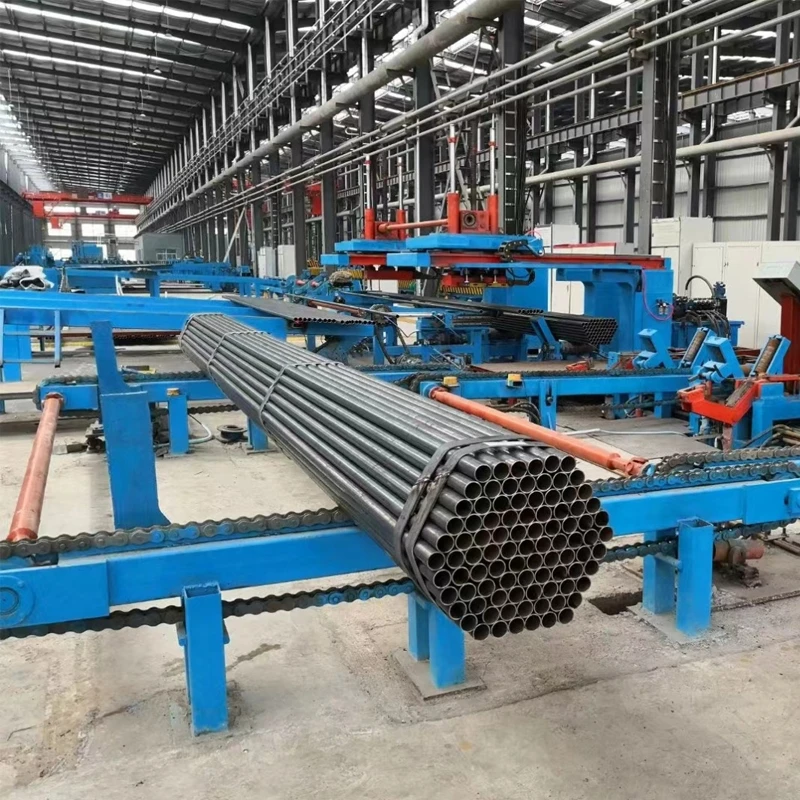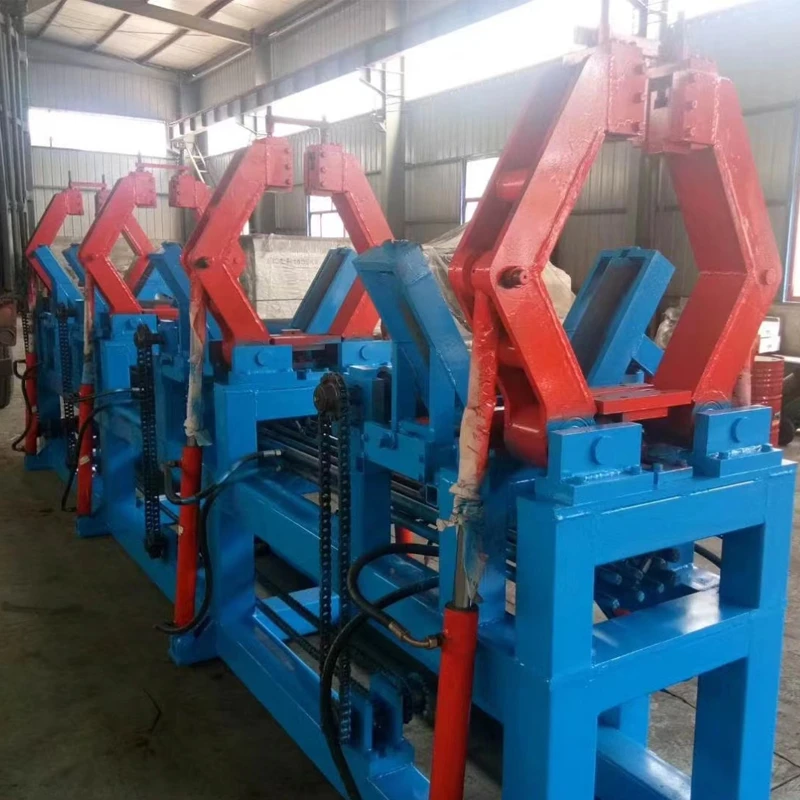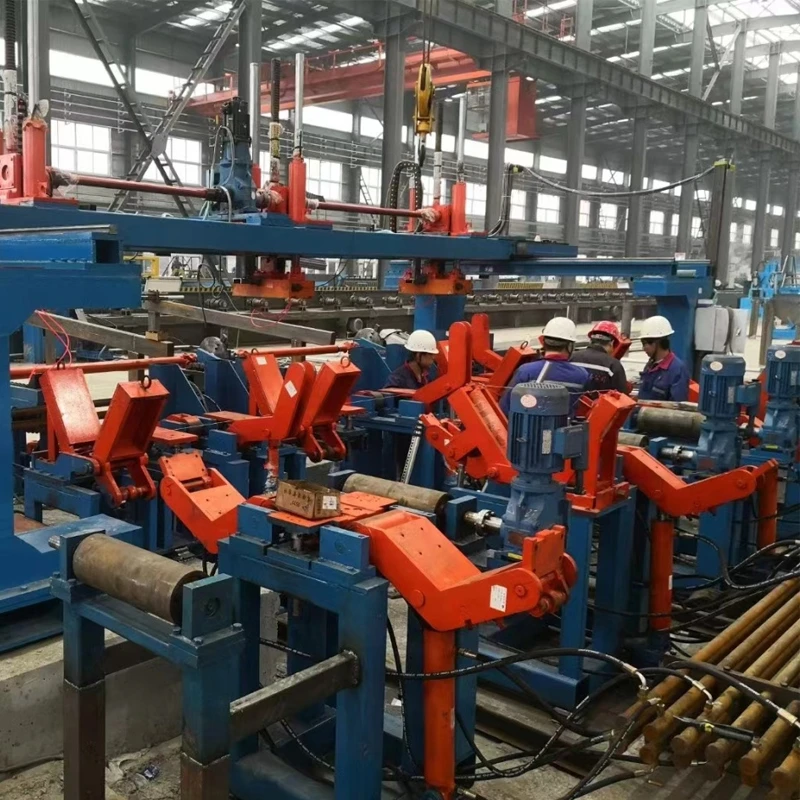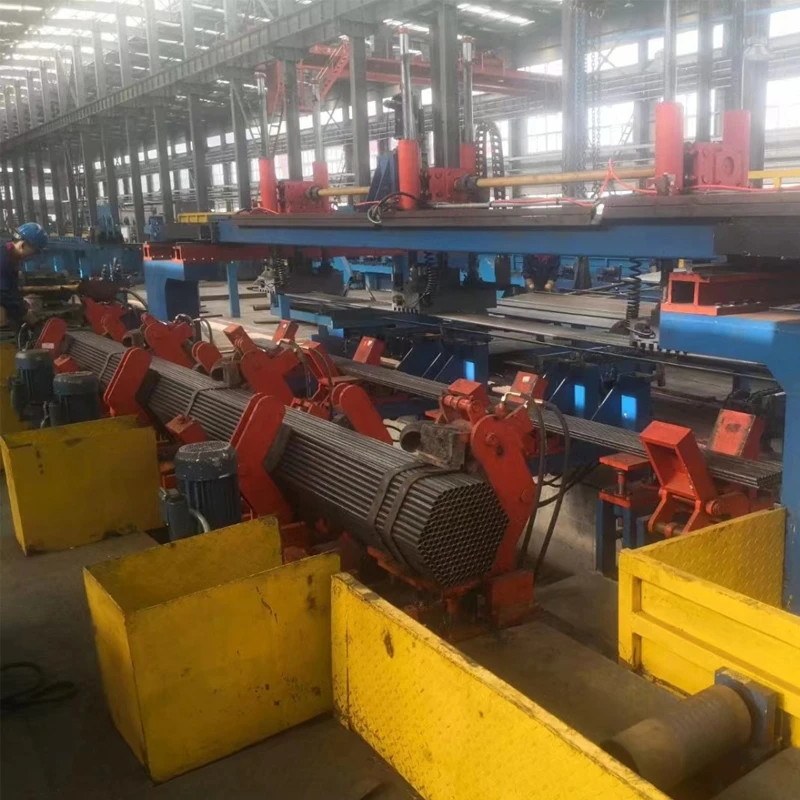Precision Belling Machine | Automated Pipe End Forming
Precision Engineering for Pipe Expansion: The Role of belling machine Technology
In the demanding landscape of modern industrial manufacturing, the precision and efficiency of pipe processing equipment are paramount. A pivotal technology in this domain is the belling machine, engineered to form the expanded end (bell) of a pipe, facilitating seamless, leak-proof connections. This critical process is indispensable across various industries, from water supply and drainage to sophisticated petrochemical applications, ensuring the integrity and longevity of piping infrastructure.
The continuous evolution of materials and application requirements drives the innovation in machine design, demanding higher levels of automation, precision, and durability. While technologies like purlin machine for cold-formed steel profiles, shutter machine for construction components, and erw pipe machine for electric resistance welding pipe production each serve distinct industrial niches, the belling machine holds a unique position for its direct impact on pipe joint quality and system reliability. This article delves into the technical intricacies, market relevance, and operational advantages of advanced belling equipment.
Industry Trends and Market Dynamics for Pipe Processing
The global market for plastic and metal piping systems is experiencing robust growth, primarily fueled by rapid urbanization, infrastructure development in emerging economies, and the increasing demand for efficient water and waste management solutions. According to a report by Grand View Research, the global plastic pipes market size was valued at USD 201.2 billion in 2022 and is expected to grow at a compound annual growth rate (CAGR) of 6.5% from 2023 to 2030. This expansion directly correlates with the demand for high-performance pipe processing machinery, including the belling machine.
Key trends influencing this sector include:
- Automation and Digitalization: The integration of Industry 4.0 principles, including IoT sensors, advanced HMI, and predictive maintenance, is enhancing operational efficiency and reducing human error in belling operations.
- Material Versatility: Modern machines are designed to process a wider range of materials, including various grades of PVC, PE, PP, and even composite pipes, often requiring adaptive heating and forming techniques.
- Energy Efficiency: With rising energy costs and environmental regulations, manufacturers are increasingly seeking machines that offer optimized energy consumption, often through advanced heating elements and hydraulic systems.
- Precision and Repeatability: The demand for tighter tolerances and consistent bell dimensions across high-volume production runs is driving innovation in control systems and tooling.
These trends underscore the importance of investing in state-of-the-art belling machine technology to remain competitive and meet evolving market demands.
Detailed Process Flow of a Belling Machine
The manufacturing process of a pipe belling machine itself, as well as the belling process it performs, demands rigorous engineering and material science. For example, the core components of the belling machine are often crafted from high-strength tool steels (e.g., D2, H13) for tooling and precision-machined structural steel (e.g., S355, A36) for the frame, ensuring longevity and dimensional stability under continuous operation. Manufacturing processes for these components typically involve:
- Precision Casting and Forging: For complex, high-stress parts, ensuring material integrity and optimal grain structure.
- CNC Machining: To achieve micron-level tolerances for critical components like heating mandrels, clamping jaws, and hydraulic cylinders.
- Heat Treatment: For specific components to enhance hardness, wear resistance, and toughness.
- Surface Treatment: Such as hard chrome plating or nitriding for corrosion resistance and reduced friction.
All manufacturing adheres to international testing standards like ISO 9001 for quality management and often specific material standards (e.g., ASTM A519 for mechanical tubing). The typical service life of a well-maintained industrial belling machine can exceed 15-20 years.
The belling process itself involves several precisely controlled steps:
Pipe Loading: The cut pipe segment is automatically or manually fed into the machine's clamping mechanism.
Heating: The end of the pipe is precisely heated to a specific forming temperature using infrared heaters, hot air, or oil circulation. Temperature control is critical to ensure material plasticity without degradation. For PVC, temperatures typically range from 120-150°C.
Forming/Belling: A specialized forming mandrel is inserted into the heated pipe end, expanding it to the desired bell shape and internal diameter. This process often employs hydraulic or servo-driven mechanisms for controlled force and displacement.
Cooling: The formed bell is rapidly cooled, often using circulating air or water, to set its shape and prevent material shrinkage or distortion. This step is crucial for dimensional stability.
Ejection: The finished, belled pipe is released and conveyed for further processing or stacking.
Target industries include petrochemical, metallurgy, and especially water supply & drainage systems. Advantages in these scenarios include significant energy saving due to optimized heating cycles and reduced material waste, along with enhanced corrosion resistance through consistent material integrity at the joint.

Technical Specifications and Performance Parameters
Modern belling machine systems are characterized by their robust construction and sophisticated control mechanisms. Key technical specifications dictate their suitability for various production requirements. Below is a table illustrating typical parameters for a high-performance PVC pipe belling machine:
| Parameter | Specification Range | Technical Detail |
|---|---|---|
| Pipe Diameter Range (OD) | 50mm - 630mm (2" - 24") | Adaptable tooling for various pipe sizes. Larger machines for DN > 630mm are available. |
| Pipe Wall Thickness | 2.0mm - 30.0mm | Requires optimized heating profiles and forming pressure based on material gauge. |
| Belling Cycle Time | 20 - 60 seconds/pipe (size dependent) | Includes heating, forming, and cooling. High-speed models achieve lower cycle times. |
| Heating Method | Infrared (IR) or Hot Air Convection | IR for precise, rapid heating; Hot Air for uniform, gentle heating for sensitive materials. |
| Control System | PLC (Siemens/Allen-Bradley) with HMI | Offers precise control over temperature, pressure, and cycle parameters. Data logging capability. |
| Total Power Consumption | 25 kW - 120 kW (depending on size/features) | Includes heating elements, hydraulic pump, and auxiliary motors. Energy-efficient designs are prioritized. |
| Forming Pressure | Up to 150 bar (Hydraulic) | Ensures robust and consistent bell formation. Servo-hydraulic systems provide greater control. |
Understanding these specifications is crucial for matching the belling machine to specific production lines and material requirements. High-end machines often feature integrated temperature sensors for real-time feedback, advanced proportional valves for hydraulic control, and sophisticated algorithms to compensate for material variations, ensuring the highest level of product quality and process repeatability. These engineering details showcase the expertise embedded in modern belling technology.
Application Scenarios and Technical Advantages
The versatility of the belling machine makes it indispensable across numerous sectors, particularly where robust and reliable pipe connections are critical.
- Water Supply & Drainage Systems: PVC and PE pipes for municipal water distribution, sewage lines, and storm drains extensively utilize belled ends for solvent-welded or gasketed joints. The precision of the bell ensures tight seals, preventing leakage and ingress of contaminants.
- Agricultural Irrigation: Large-diameter PE pipes for irrigation require robust connections that can withstand varying pressures and environmental conditions. Belling provides a cost-effective and durable joining method.
- Industrial Piping: For chemical processing, mining, and other industrial applications, specialized plastic pipes often need custom bell dimensions for unique coupling requirements, which a flexible belling machine can accommodate.
- Conduit and Cable Protection: Electrical conduits and communication cable protection pipes, typically made from PVC or HDPE, are belled to facilitate easy and secure coupling during installation.
The technical advantages offered by advanced belling technology are substantial:
- Enhanced Joint Integrity: Precision belling ensures optimal fit for gaskets or solvent cement, creating stronger, leak-proof connections that meet international standards (e.g., ISO 4437, AWWA C900).
- Material Savings and Reduced Waste: Accurate heating and forming minimize material distortion, reducing scrap rates and optimizing raw material usage.
- Increased Production Efficiency: Automated systems with quick changeover times significantly boost throughput and reduce labor costs. A single belling machine can process thousands of pipes per shift.
- Energy Efficiency: Modern infrared heating systems and intelligent temperature control algorithms consume up to 20% less energy compared to older convection heating methods.
- Versatility: Adaptable tooling and programmable controls allow for the production of various bell types (e.g., R-type, U-type, square type) and different pipe materials.

Vendor Comparison and Selection Criteria
Choosing the right belling machine vendor is a strategic decision that impacts long-term operational costs and product quality. Beyond initial purchase price, factors such as machine performance, reliability, after-sales support, and customization capabilities are crucial.
| Feature/Criterion | Vendor A (Premium) | Vendor B (Mid-Range) | Vendor C (Budget) |
|---|---|---|---|
| Automation Level | Fully Automatic, Industry 4.0 Ready | Semi-Automatic with PLC Control | Manual Loading, Basic PLC |
| Heating System | Advanced IR with Multi-Zone Control | Standard IR or Hot Air | Basic Heating Elements |
| Precision (Bell Tolerance) | +/- 0.1mm | +/- 0.3mm | +/- 0.5mm |
| Energy Efficiency | High (Energy Recovery, Optimized Cycles) | Medium (Standard) | Lower |
| After-Sales Support | Global Network, Remote Diagnostics, 24/7 | Regional Support, Business Hours | Limited, Local Agents |
| Certifications | ISO 9001, CE, UL Compliant | ISO 9001, CE | Basic CE |
| Customization Options | Extensive (Material, Size, Automation) | Moderate (Tooling, Basic Features) | Limited (Standard Configurations) |
When evaluating vendors, prospective buyers should look for companies with a proven track record (e.g., 10+ years in the industry), strong client testimonials, and a commitment to R&D. Certifications like ISO 9001 demonstrate a commitment to quality management systems. Requesting live demonstrations or site visits to existing installations can provide invaluable insights into actual machine performance and reliability.
Customized Solutions for Unique Production Demands
Not all pipe production lines are created equal. Many manufacturers face unique challenges related to specialized pipe materials, non-standard diameters, complex bell geometries, or integration with existing extrusion and cutting lines. This is where customized belling machine solutions become essential.
Leading manufacturers of belling equipment offer comprehensive customization services, which can include:
- Tailored Tooling Design: Development of specific mandrels and clamping jaws for unusual pipe dimensions or complex bell shapes, ensuring optimal material flow and minimal stress.
- Material-Specific Heating Systems: Implementing specialized heating zones or cooling cycles optimized for particular polymers (e.g., cross-linked polyethylene PEX, or high-density polyethylene HDPE) to achieve ideal plasticity and structural integrity.
- Integrated Automation Solutions: Seamless integration with upstream (extrusion, cutting) and downstream (stacking, packaging) equipment, often involving custom conveyor systems, robotic handling, and centralized PLC control. This can include specialized automation for high-speed production of smaller diameter pipes, similar to the efficiency required for components made on a purlin machine.
- Environmental Adaptations: Designing machines to operate efficiently in challenging environments, such as high-temperature workshops or facilities requiring specific dust or moisture protection.
- Software and HMI Customization: Developing user interfaces and control logic tailored to specific operator needs or data reporting requirements, enhancing ease of use and process monitoring.
Engaging in a collaborative engineering process with the vendor from the initial concept phase ensures that the final belling machine solution precisely addresses the client's production goals, resulting in higher ROI and operational excellence.

Application Case Studies: Proving Reliability in Practice
Real-world application demonstrates the true value and performance of a belling machine. Here are two examples reflecting operational experience and success:
Case Study 1: Project AquaFlow - High-Volume PE Pipe Belling for Municipal Water Supply
A major municipal pipe manufacturer in Southeast Asia faced challenges with inconsistent bell dimensions and slow throughput for their PE pipe production line, producing pipes ranging from 200mm to 500mm for a new city-wide water distribution network. They sought a solution that could guarantee precision and significantly increase production capacity.
- Solution Implemented: A custom-designed, fully automatic belling machine with an advanced multi-zone IR heating system and servo-hydraulic forming unit. The machine was integrated with their existing extrusion line, including a specialized pipe handling system for large diameter PE pipes.
-
Results:
- Production throughput increased by 40%, meeting aggressive project deadlines.
- Bell dimension consistency improved to within +/- 0.15mm, leading to a 75% reduction in pipe joint leakage during installation.
- Energy consumption for the belling process decreased by 18% due to optimized heating cycles.
- Operator feedback highlighted ease of use and minimal maintenance requirements, contributing to higher overall equipment effectiveness (OEE).
Case Study 2: Metropolis Infrastructure - Large-Diameter PVC Pipe Solutions for Storm Drainage
A pipe manufacturer supplying large-diameter (up to 630mm) PVC pipes for a major urban storm drainage project required a belling machine capable of handling heavy-wall pipes and producing robust solvent-weld bells. Reliability and quick changeover for various pipe lengths were critical.
- Solution Implemented: A heavy-duty belling machine featuring reinforced structural components, a powerful hydraulic system for forming thick-walled pipes, and a proprietary hot-air convection heating system for uniform heat penetration without material degradation. The machine included an automated length adjustment system for rapid setup changes.
-
Results:
- Maintained bell quality and structural integrity on PVC pipes with wall thicknesses up to 30mm.
- Reduced changeover time between different pipe lengths by 60%, significantly improving production flexibility.
- The manufacturer received commendations for the consistent quality of their pipes, meeting stringent project specifications.
- The machine operated continuously for over two years with minimal unscheduled downtime, demonstrating exceptional reliability.
Ensuring Quality, Trustworthiness, and Support
Certifications and Authoritative Standards
Commitment to quality is foundational. Reputable belling machine manufacturers adhere to rigorous international standards. Our manufacturing facilities are ISO 9001:2015 certified, guaranteeing robust quality management systems from design to delivery. All equipment also complies with CE marking directives, ensuring compliance with European safety, health, and environmental protection requirements. Component sourcing also prioritizes suppliers meeting specific material standards such as ASTM for metals and plastics.
Frequently Asked Questions (FAQ)
- Q1: What pipe materials can your belling machines process?
- A1: Our machines are primarily designed for PVC, PE, and PP pipes. With custom tooling and heating adjustments, we can accommodate other thermoplastic materials. Please contact us with your specific material requirements.
- Q2: What is the typical lead time for a custom belling machine?
- A2: Standard models typically have a lead time of 8-12 weeks. Custom configurations, depending on complexity, may require 16-24 weeks. We provide detailed lead time estimates upon project scope finalization.
- Q3: What kind of warranty is offered with your belling machines?
- A3: We offer a standard 12-month warranty on all mechanical and electrical components from the date of commissioning or 18 months from shipment, whichever comes first. Extended warranty options are available.
- Q4: How do you ensure optimal energy efficiency in your belling machines?
- A4: Our machines incorporate advanced PID temperature control, efficient insulation for heating zones, and high-efficiency motors for hydraulic systems. Infrared heating systems are optimized for rapid and localized heating, minimizing overall energy consumption.
Lead Time & Fulfillment Details
Upon order confirmation, a dedicated project manager is assigned to oversee every stage, from design approval to manufacturing, testing, and logistics. Our structured production process ensures timely fulfillment, with regular progress updates provided to clients. Pre-shipment testing and factory acceptance tests (FAT) are standard procedures, ensuring machines meet all specified performance criteria before dispatch.
Warranty and After-Sales Support
Our commitment extends far beyond the sale. We provide comprehensive after-sales support, including:
- Installation & Commissioning: On-site assistance by skilled technicians to ensure seamless integration and optimal performance.
- Operator Training: Thorough training programs for your personnel to maximize operational efficiency and safety.
- Technical Support: 24/7 remote and on-site technical assistance to address any operational queries or issues.
- Spare Parts Availability: A readily available inventory of genuine spare parts to minimize downtime.
- Preventative Maintenance Programs: Tailored service agreements to ensure the long-term reliability and peak performance of your belling machine.

Conclusion
The advanced belling machine stands as a cornerstone technology in modern pipe manufacturing, delivering the precision, efficiency, and reliability demanded by today's infrastructure projects. From ensuring leak-proof water supply networks to facilitating robust industrial piping, its role is critical. As industries continue to evolve towards greater automation and higher material performance, investing in state-of-the-art belling technology is not just an operational upgrade, but a strategic imperative for long-term success. The integration of smart controls, energy-efficient designs, and comprehensive support systems ensures that these machines continue to drive innovation and productivity in pipe production worldwide.
References
- Grand View Research. (2023). Plastic Pipes Market Size, Share & Trends Analysis Report. Retrieved from [Insert relevant industry report source if available, e.g., grandviewresearch.com]
- International Organization for Standardization. ISO 9001:2015 - Quality management systems - Requirements.
- American Society for Testing and Materials. ASTM International Standards for Pipe and Piping Systems.
- European Committee for Standardization. CE Marking Directives for Machinery.
- Smith, J. (2021). "Advancements in Thermoplastic Pipe Forming Technologies." Journal of Polymer Engineering, 41(3), 195-208.
- Chen, L., & Wang, Q. (2022). "Optimization of Heating and Cooling Cycles in PVC Pipe Belling for Enhanced Dimensional Stability." International Journal of Manufacturing Technology and Management, 35(1), 55-70.
-
High-Efficiency Automatic Belling Machine for PipesNewsAug.26,2025
-
High-Quality Line Pipe Steel for Oil & Gas PipelinesNewsAug.21,2025
-
Advanced PVC Belling Machine for Efficient Pipe ProductionNewsAug.19,2025
-
High-Frequency Straight Seam Welded Pipe Production Line-BzZhou Xinghua Machinery Equipment Manufacturing Co., Ltd.|Steel Pipe Manufacturing, Precision EngineeringNewsAug.18,2025
-
High Quality Enamel/Pre-seasoned Camping Square Cast Iron Grill Pan-BzZhou Xinghua Machinery Equipment Manufacturing Co., LTD.NewsAug.18,2025


